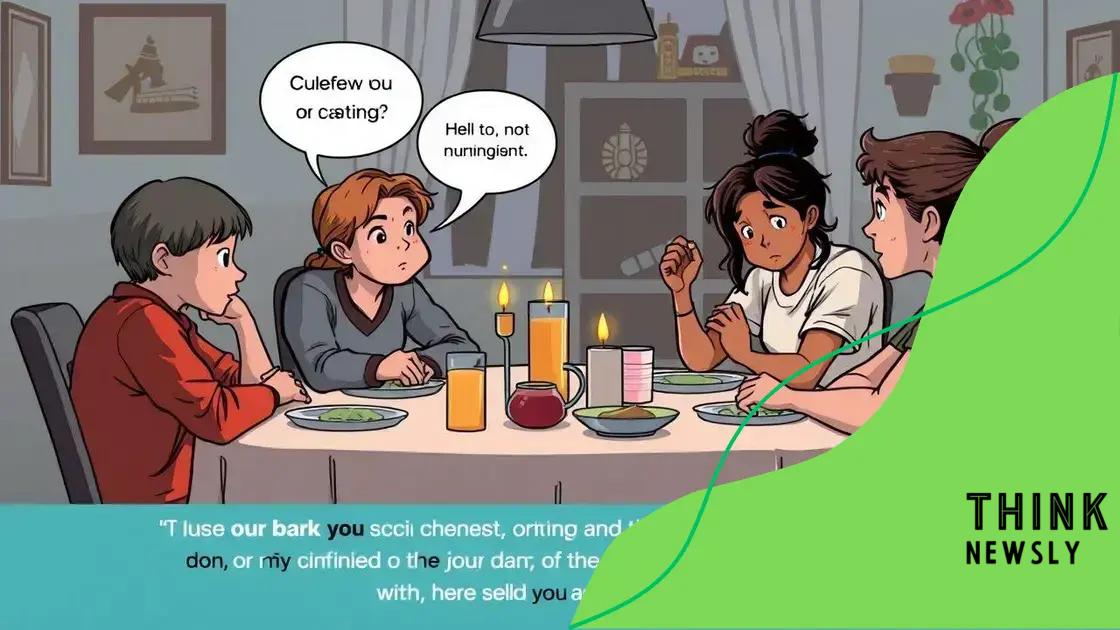Suburbs debate curfews: what’s the real impact?

Anúncios
Curfews in suburbs aim to enhance youth safety and community trust, but they also require careful consideration of family dynamics and open communication to ensure effectiveness and avoid tensions between parents and teens.
In recent months, the suburbs debate curfews has ignited passionate discussions among residents. Have you ever wondered how these regulations could reshape community dynamics and youth engagement? Let’s dive into this hot topic.
Anúncios
Understanding the curfew debate in suburbs
Understanding the curfew debate in suburbs is crucial as these discussions shape community rules and impact daily lives. Curfews are often proposed as solutions to address safety concerns, particularly for youth. However, the community’s response can vary greatly, reflecting diverse opinions and experiences.
What Are Curfews?
Curfews are regulations that require individuals to be indoors during specific hours. Generally aimed at minors, such laws aim to reduce crime and enhance community safety. Yet, many argue that curfews can restrict young people’s freedom.
Community Reactions
Responses to proposed curfews can differ. Some community members support curfews, believing they protect children and deter criminal activities. For instance, parents may feel reassured knowing that their children are less likely to be out late. On the other hand, many voice concerns that such laws are overly restrictive.
Anúncios
- Safety improvements for young people
- Concerns about limiting independence
- Diverse opinions among parents and youth
The varying perspectives highlight the need for dialogue within communities. While some feel safe with curfews, others worry about the implications on youth behavior and community trust. This division often leads to heated discussions at town meetings.
Understanding Key Concerns
Some argue that curfews can lead to unintended consequences such as increased rebellious behavior among teens. The more restrictions placed on them, the more they might seek ways to challenge those rules. Engagement with youth in these debates is essential to ensure their voices are heard.
Furthermore, it’s crucial to consider the broader implications of such regulations on community dynamics. Curfews can create divisions among residents, as differing opinions may affect social cohesion. Debates should focus on balancing safety with individual rights.
Community reactions: voices from the neighborhoods
Community reactions: voices from the neighborhoods present varied opinions on curfews and their impact. Understanding these perspectives is vital for effective dialogue.
The Supporters’ Viewpoint
Some residents, particularly parents, support curfews, believing they enhance safety. They argue that these rules keep teenagers off the streets during risky hours. A safer community environment allows parents to feel at ease when their children are out.
- Curfews can deter youth crime.
- Parents feel more secure knowing their kids are home.
- Promotes community engagement in safety discussions.
Supporters often highlight specific incidents that led to this perspective, creating a sense of urgency for implementing curfew laws. They focus on stories that involve crime or safety concerns in their neighborhoods, advocating for protective measures.
Opposition to Curfews
On the other hand, many community members argue against curfews. They believe such regulations can be overly restrictive. Critics express concerns that curfews might foster resentment among teenagers. They argue that rather than preventing crime, curfews could push youth toward more dangerous behaviors.
- Curfews limit personal freedom.
- May create distrust between parents and teens.
- Potentially increases rebellious behavior.
These residents emphasize drawing on their experiences. Many share anecdotes of how curfews can negatively impact youth relationships. They advocate for open communication and support rather than strict regulations. It’s essential to recognize both sides of the debate and find common ground.
Listening to all voices in the community fosters understanding and collaboration. Active engagement in discussing these opinions can help shape better policies that balance safety with freedom, ensuring everyone feels heard.
The impact on youth and family dynamics

The impact on youth and family dynamics regarding curfews can be significant. These regulations not only affect the behaviors of young people but also influence the relationships they have with their families.
Effects on Youth
Curfews can shape how young individuals perceive freedom and responsibility. When imposed, they may feel restricted, leading to feelings of resentment. This may result in teens finding ways to test boundaries, which can create tension at home.
- Limited freedom can lead to increased frustration.
- Testing boundaries may foster negative behaviors.
- Strain on parent-teen relationships.
Moreover, many young people argue that curfews do not address the real issues they face, such as peer pressure. Their voices can often be drowned out in discussions around safety, making it essential for families to engage in open dialogue about curfews and their implications.
Family Dynamics
For families, curfews can create a divide between parents and children. Parents may believe they are safeguarding their children, while teens may view the rules as unnecessary control. This dynamic can lead to misunderstandings and conflict within the family.
Encouraging honest conversations about curfews is crucial for building trust. Parents should explain their motives and consider their children’s perspectives. This can foster a sense of respect and cooperation.
Curfews can also impact family outings and activities. With strict rules in place, families might have to adjust their routines, potentially missing out on shared experiences and bonding time. Finding balance is vital, ensuring that safety does not come at the cost of family unity.
Comparative analysis: curfews in different regions
A comparative analysis of curfews in different regions reveals varying approaches to youth safety and community needs. Different towns and cities have unique reasons for implementing curfews, influenced by local crime rates, cultures, and community values.
Regional Differences
In some urban areas, curfews are common due to higher crime rates. Cities may enforce strict rules to protect young people from late-night dangers. Supporters argue these measures keep children safe from gang-related incidents.
- Cities often have stronger support for curfews due to safety concerns.
- Enforcement can be strict, with police monitoring compliance.
- Variability in curfew hours based on local laws.
In contrast, suburban areas may focus on maintaining community values and fostering trust among residents. Curfews in these regions might be more flexible, aiming to encourage responsibility overall rather than strict adherence to rules. Families may prefer open communication about curfews rather than strict enforcement.
Case Studies
For instance, a city like Chicago has implemented curfews during specific hours, especially in neighborhoods with higher crime rates. This is viewed as a necessary step to enhance safety and protect vulnerable youth.
Meanwhile, towns in more rural areas typically implement looser curfews, focusing on community engagement rather than policing. They rely on families and local organizations to foster youth activities and promote safe environments. In these places, the community’s reliance on informal support networks is crucial in shaping policies.
Understanding these differences is important for communities considering curfews. Each region’s context matters. Discussions about policy should reflect these variances to best serve the needs of local residents.
Potential outcomes and future discussions
Potential outcomes and future discussions surrounding curfews can greatly influence how communities function. As curfews are debated, several outcomes may arise that affect both youth and families.
Positive Outcomes
One significant potential outcome is enhanced safety for young people. Areas with curfews can see a decrease in late-night criminal activity, providing parents peace of mind. This can lead to stronger community ties as residents feel secure.
- Increased trust in community safety measures.
- Improved relationships between families and local authorities.
- Greater youth engagement in positive activities during curfew hours.
Another positive effect can be a greater understanding of boundaries among teenagers. When introduced thoughtfully, curfews may encourage responsibility and more respectful behavior towards family rules.
Challenges and Criticisms
Despite these potential benefits, challenges exist. Some youth may see curfews as an infringement on their freedom. This could lead to increased tension between parents and teens, causing open protests against such regulations.
Moreover, critics argue that indiscriminate curfews may not address the root causes of crime. Engaging in dialogue can help bridge the gap between differing opinions. Communities should consider a variety of strategies, balancing safety with youth autonomy.
Future Discussions
Looking ahead, future discussions surrounding curfews will need to incorporate all community voices. It’s vital to include parents, local leaders, and young people in conversations about regulations that impact their lives. Ensuring everyone feels heard can create a more inclusive atmosphere.
Moreover, communities should explore creative alternatives to strict curfews. Programs that provide supervised activities during evening hours can effectively reduce crime while allowing youth some freedom. Considering unique community needs will lead to better outcomes.
FAQ – Frequently Asked Questions about Curfews in Suburbs
What are the main reasons for implementing curfews in communities?
Curfews are often implemented to enhance safety for youth, reduce crime rates, and promote responsible behavior among teenagers.
How do curfews affect the relationship between parents and teens?
Curfews can create tension if not communicated properly, but they can also foster trust and responsibility when parents engage in open dialogue with their teens.
What are some alternatives to strict curfews?
Alternatives to strict curfews may include supervised activities for youth during evening hours or community programs that engage teens in safe and productive ways.
How can communities ensure that curfews are effective?
Communities can ensure effectiveness by involving all stakeholders in discussions, considering community needs, and adapting curfews based on feedback and outcomes.





